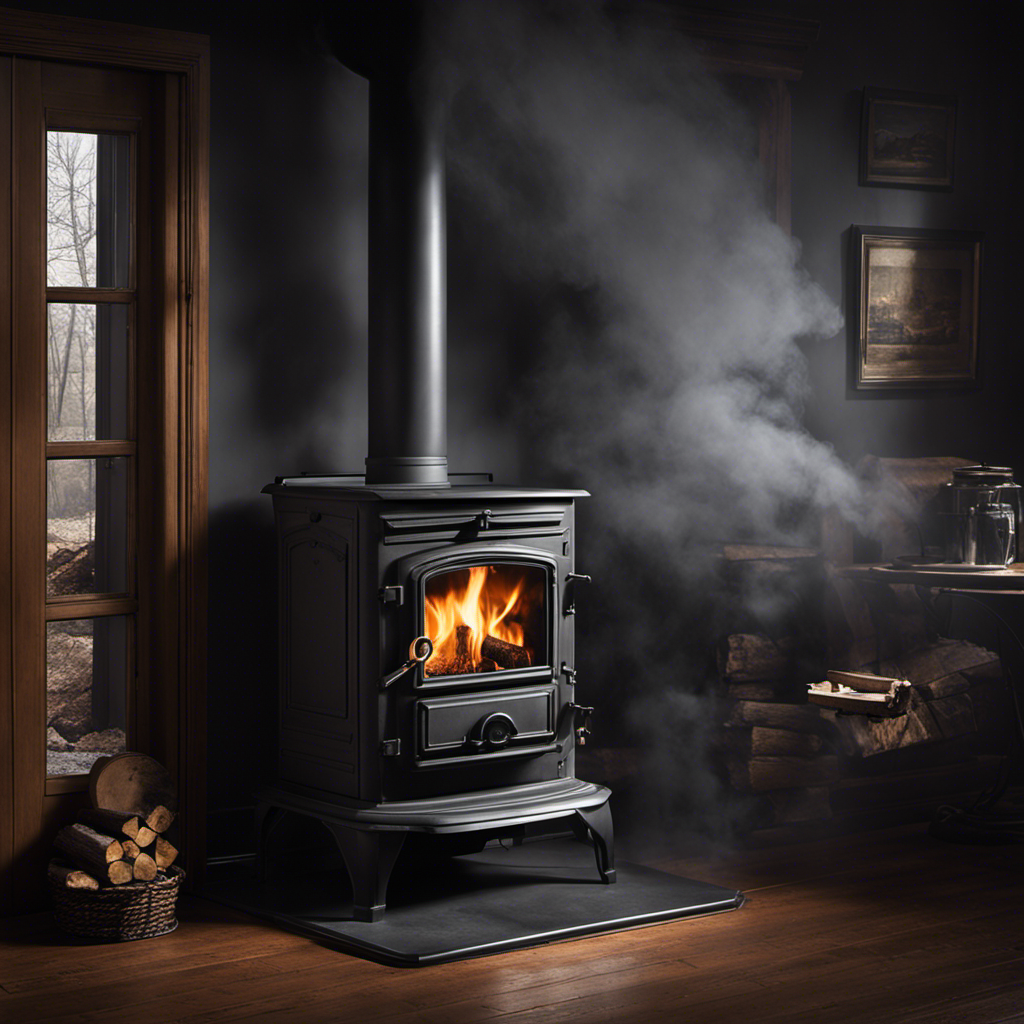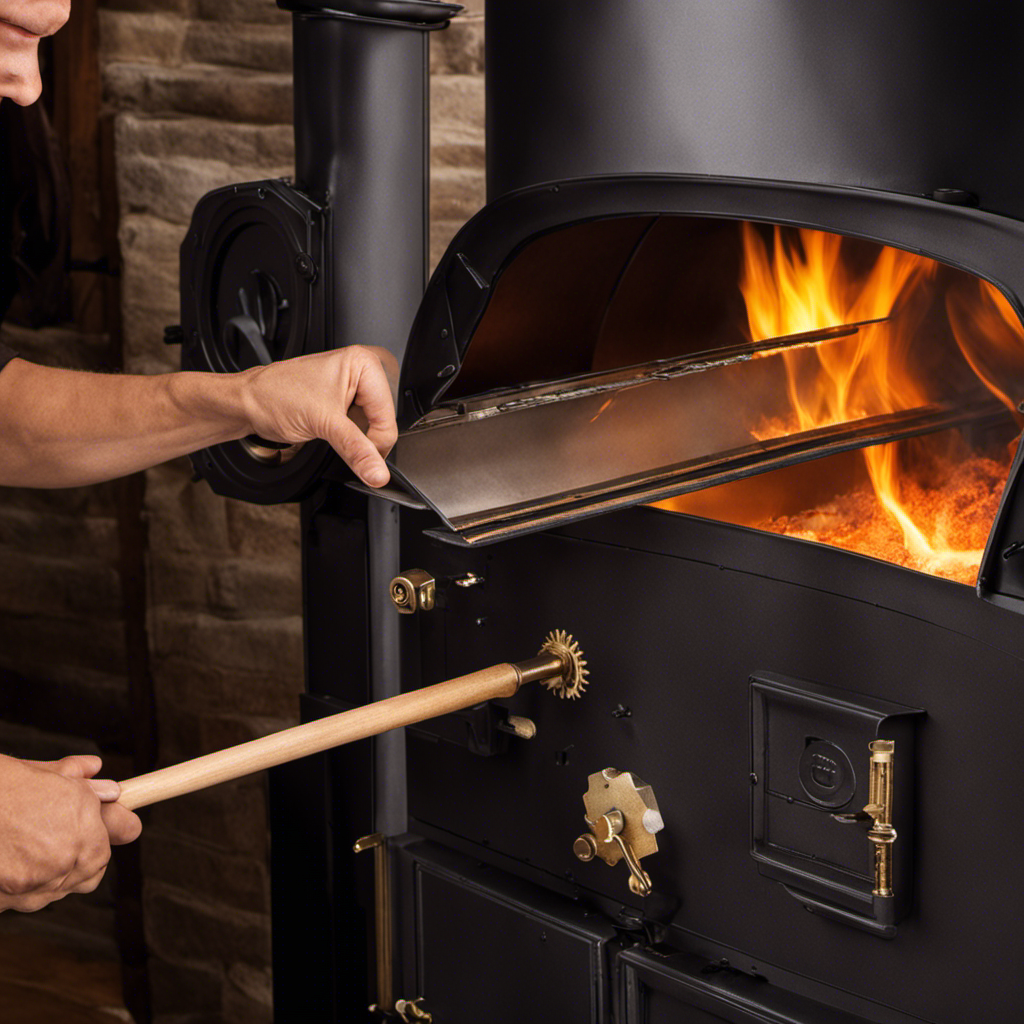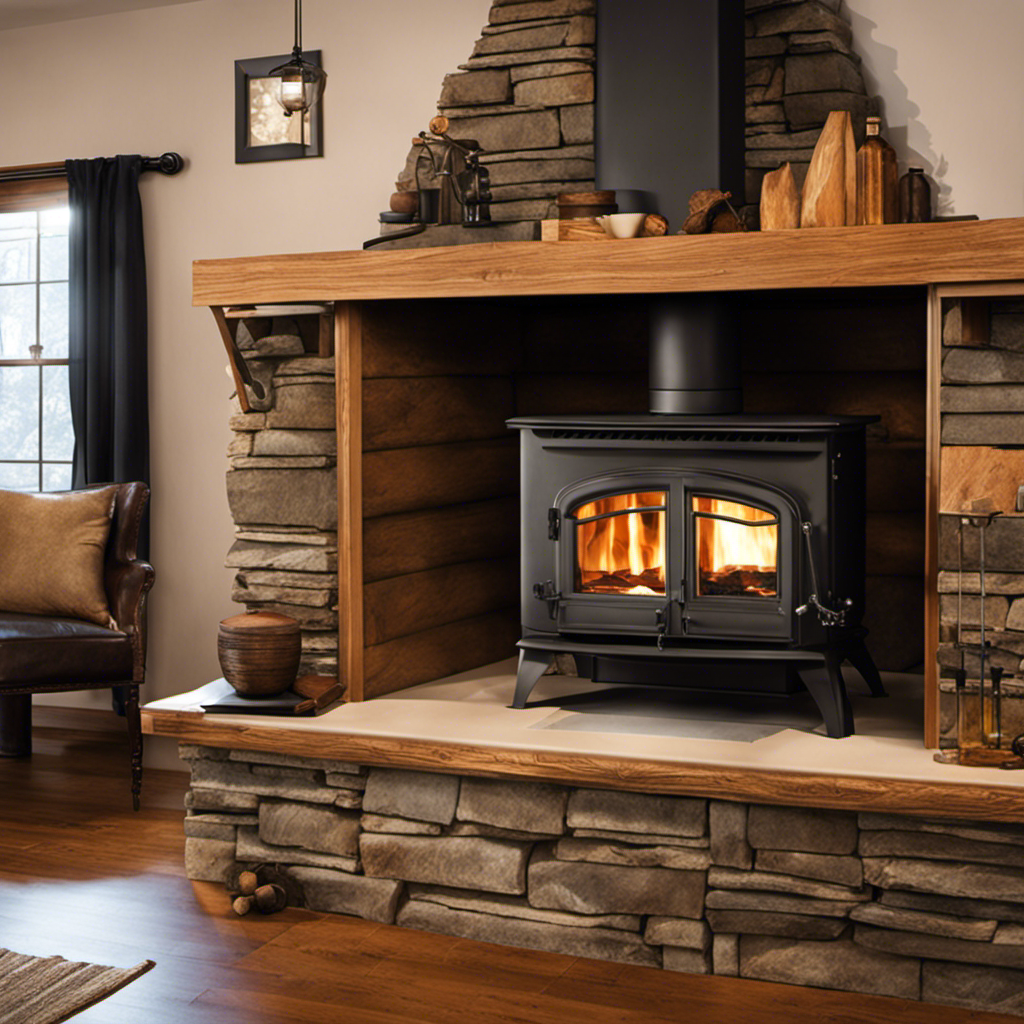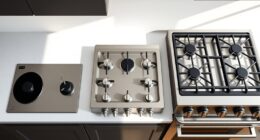I imagined warm evenings spent by the fireplace, listening to the gentle crackling of a wood stove. I didn’t consider, however, that it would also entail regularly maintaining the chimney. Still, this minor inconvenience is a small sacrifice for ensuring safety and efficiency, don’t you agree?
In this article, I’ll guide you through the ins and outs of cleaning your wood stove chimney. From understanding the factors to consider, to the recommended cleaning schedule, and even the signs that your chimney needs attention, I’ve got you covered.
Let’s keep those fires burning safely!
Key Takeaways
- The type of wood burned and its moisture content affects creosote buildup in a wood stove chimney.
- Regular chimney inspections and cleanings are recommended to ensure safe and efficient operation.
- The frequency of chimney cleaning depends on the wood type and moisture content, with higher moisture content requiring more frequent cleaning.
- Signs that indicate the need for chimney cleaning include excessive smoke, foul odors, poor draft, soot accumulation, and the presence of nesting materials or animal sounds.
Factors to Consider
When considering how often to clean my wood stove chimney, I take into account factors such as the type of wood I burn and the frequency of use. These factors play a crucial role in determining the frequency of chimney cleaning.

The type of wood burned affects how quickly creosote builds up in the chimney. Hardwoods like oak and maple produce less creosote compared to softwoods like pine and cedar. Additionally, the frequency of use also impacts the accumulation of creosote. If I use my wood stove daily during the winter, it’s recommended to clean the chimney at least once a year. However, if I use it less frequently, cleaning every two or three years may be sufficient.
When it comes to cleaning techniques, there are a few options to consider. The traditional method involves using a chimney brush to physically remove the creosote buildup. This requires accessing the chimney from the roof or through the stovepipe. Another technique is chemical cleaning, which involves using creosote-dissolving products that break down the buildup. This method is often used as a supplement to mechanical cleaning. It’s important to follow the manufacturer’s instructions and safety precautions when using chemical cleaners.
Recommended Cleaning Schedule
I should make sure to regularly maintain my wood stove chimney to avoid any potential issues. As a responsible homeowner, I understand the importance of keeping my chimney clean and well-maintained.
Here are some recommendations for cleaning and maintaining a wood stove chimney:

-
Schedule regular chimney inspections: It’s recommended to have a professional chimney sweep inspect your chimney at least once a year. They can identify any potential issues and advise on the frequency of cleaning.
-
Use recommended cleaning products: When it comes to cleaning your chimney, it’s crucial to use the right products. Choose cleaning solutions that are specifically designed for removing creosote and soot buildup. These products are effective and safe for use in wood stove chimneys.
-
Consider chimney sweep services: Hiring a professional chimney sweep can ensure a thorough cleaning of your chimney. They have the expertise and specialized tools to remove any debris or obstructions safely.
-
Clean the chimney regularly: Depending on your usage, it’s generally recommended to clean your wood stove chimney every 40-60 fires. This frequency may vary based on the type of wood you burn and the condition of your chimney.
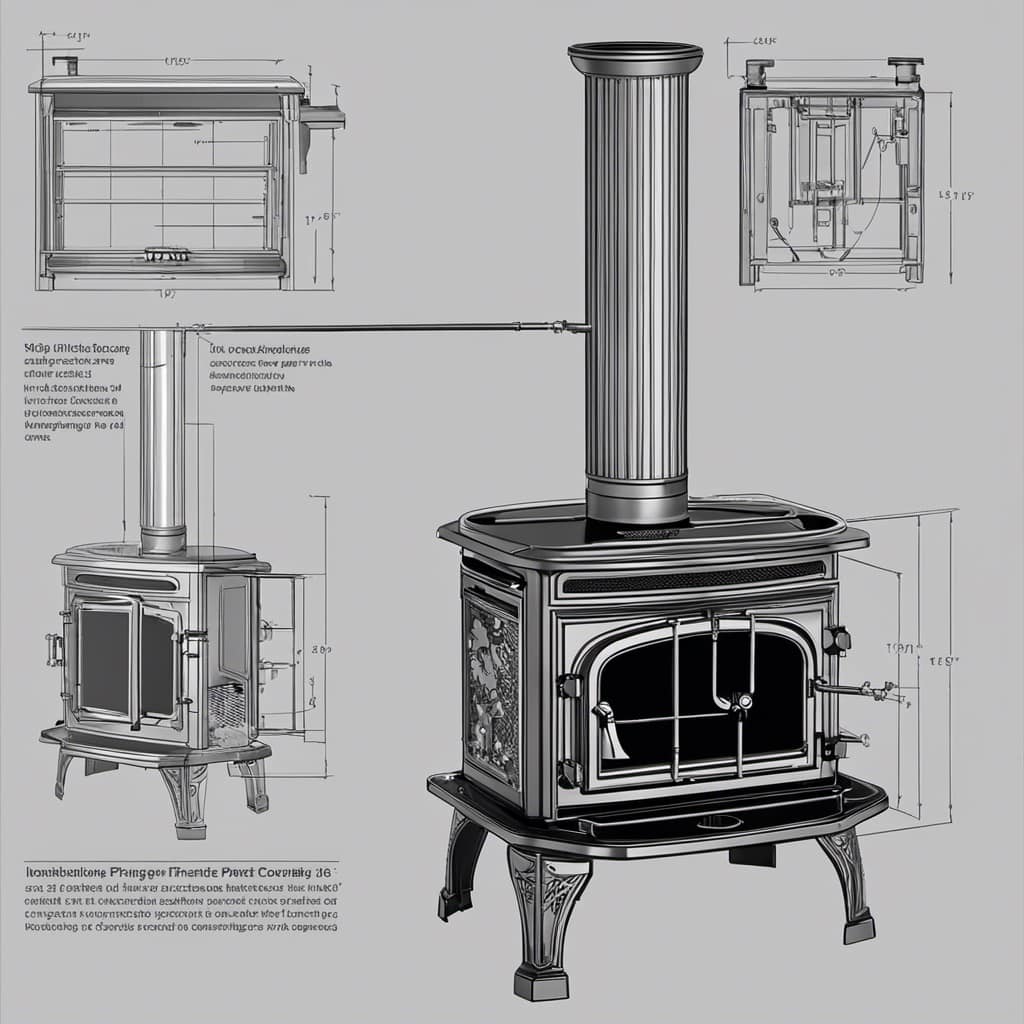
-
Follow proper safety precautions: Always take necessary safety precautions when cleaning your chimney. Use protective gear such as gloves and goggles, and ensure proper ventilation in the area.
Frequency Based on Wood Type
Based on the type of wood I burn, I need to consider the frequency of cleaning my chimney. The moisture content of the wood plays a significant role in determining how often I should clean my chimney. Wood with higher moisture content produces more creosote, a highly flammable substance that can accumulate in the chimney and increase the risk of chimney fires. To help you understand the recommended cleaning schedule based on wood moisture, I have created the following table:
| Wood Moisture Content | Cleaning Frequency |
|---|---|
| Below 20% | Once per year |
| 20% – 25% | Twice per year |
| Above 25% | Three times per year |
Signs Your Chimney Needs Cleaning
To ensure optimal performance and safety, it’s important for me to be aware of the signs that indicate my chimney needs cleaning. Regular maintenance is crucial to prevent chimney fires and carbon monoxide leaks. Here are the signs that indicate it’s time for a cleaning:
-
Excessive smoke: If I notice a significant increase in smoke coming out of the chimney while using my fireplace or wood stove, it could be a sign of a blockage or buildup.
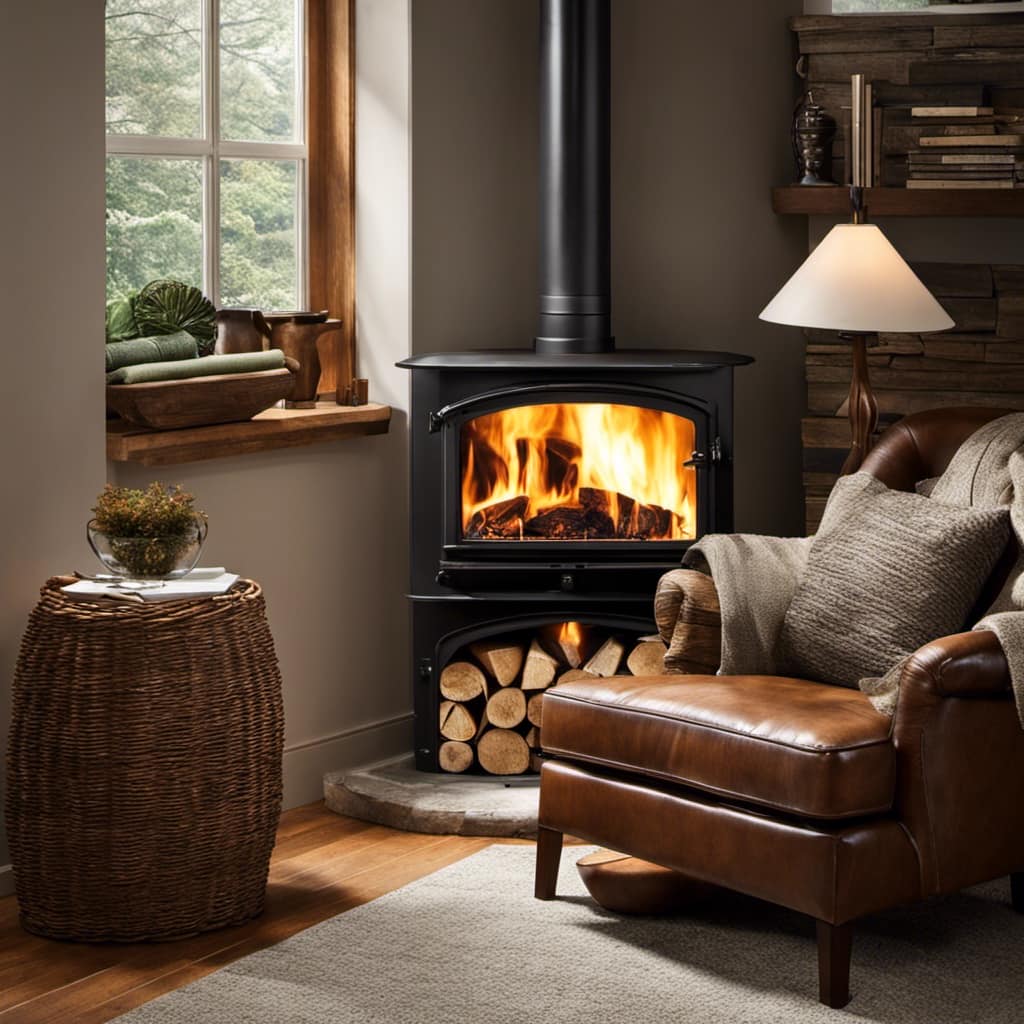
-
Foul odors: A strong, unpleasant smell coming from the fireplace could indicate the presence of creosote, a flammable substance that builds up in the chimney.
-
Slow or poor draft: If the smoke doesn’t rise properly or if it takes longer for the fire to ignite, it could be due to a partially blocked chimney.
-
Soot accumulation: If I see a buildup of soot or black residue on the damper or fireplace walls, it’s a clear sign that the chimney needs cleaning.
-
Animal activity: The presence of nesting materials, droppings, or animal sounds in the chimney suggests that it needs to be cleaned and secured.
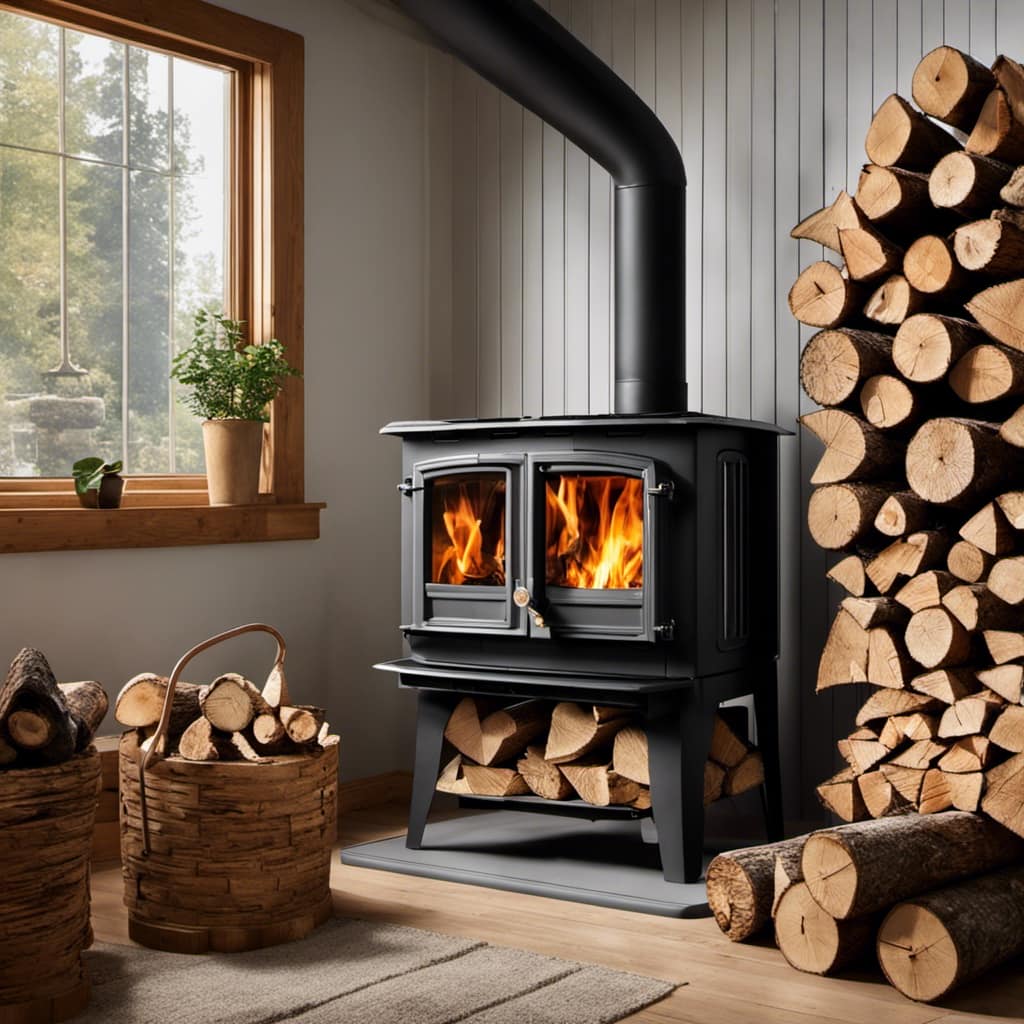
When it comes to cleaning methods, it’s best to hire a professional chimney sweep. They’ve the expertise and specialized tools to thoroughly clean the chimney, removing all creosote and blockages. Regular inspections and cleanings by a professional will ensure the safe and efficient operation of my chimney.
Importance of Regular Maintenance
Regular maintenance is crucial for ensuring the safety and efficiency of your wood stove chimney. By regularly cleaning and inspecting your chimney, you can prevent the buildup of creosote, which can lead to chimney fires.
Additionally, regular maintenance allows you to identify and address any issues that may be affecting the optimal performance of your stove, ensuring that it operates at its best.
Prevent Chimney Fires
I always make sure to clean my wood stove chimney regularly to prevent chimney fires. It’s crucial to take preventive measures to avoid the dangerous buildup of creosote.
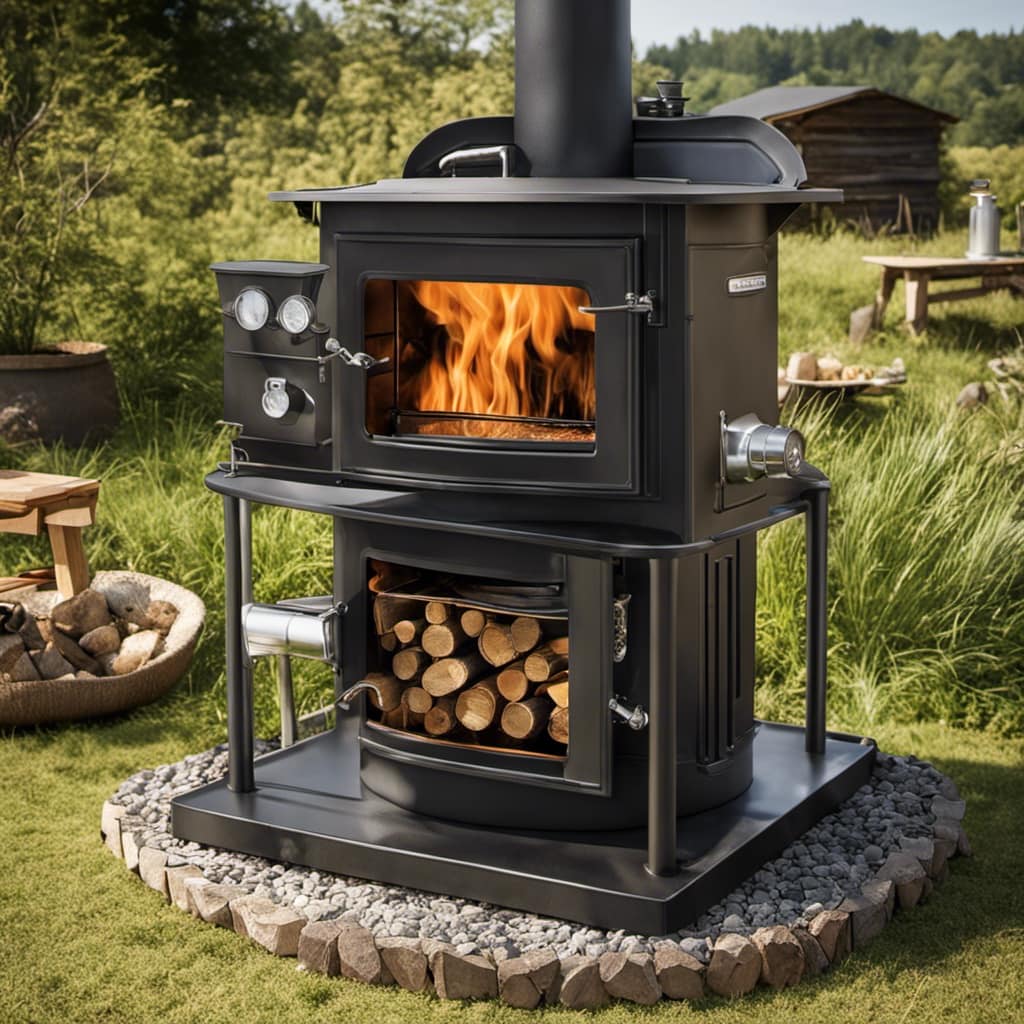
Here are some cleaning techniques for different chimney types:
- Inspect the chimney regularly to identify any signs of creosote buildup or blockage.
- Use a wire chimney brush to scrub the inside of the chimney thoroughly.
- For masonry chimneys, consider using a chemical cleaner specifically designed to remove creosote.
- For metal chimneys, use a high-temperature chimney cleaner to effectively remove creosote deposits.
- Vacuum the chimney to remove any loose debris or soot that may have accumulated.
Ensure Optimal Stove Performance
To keep my wood stove running efficiently, I always make sure to use dry and seasoned firewood. This not only helps to maintain a cleaner burn but also prevents excessive creosote buildup in the chimney. However, there are other maintenance tips that can further improve stove efficiency. Regular cleaning of the stove and chimney is crucial to remove any accumulated soot or debris that can hinder airflow and reduce heat output. Additionally, checking and replacing gaskets and seals, as needed, ensures a tight seal and prevents heat loss. Properly adjusting the air intake and damper settings also contributes to optimal stove performance. By following these maintenance tips, I can enjoy a more efficient and reliable wood stove experience.
| Maintenance Tips | Benefits |
|---|---|
| Use dry firewood | Cleaner burn, less creosote buildup |
| Regular cleaning | Improved airflow, increased heat output |
| Check gaskets and seals | Tighter seal, reduced heat loss |
| Adjust air intake and damper | Better control of combustion process |
DIY Vs Professional Cleaning
When it comes to cleaning, the decision between DIY and professional cleaning can be a tough one.
While DIY cleaning may seem cost-effective, it’s important to consider the pros and cons.
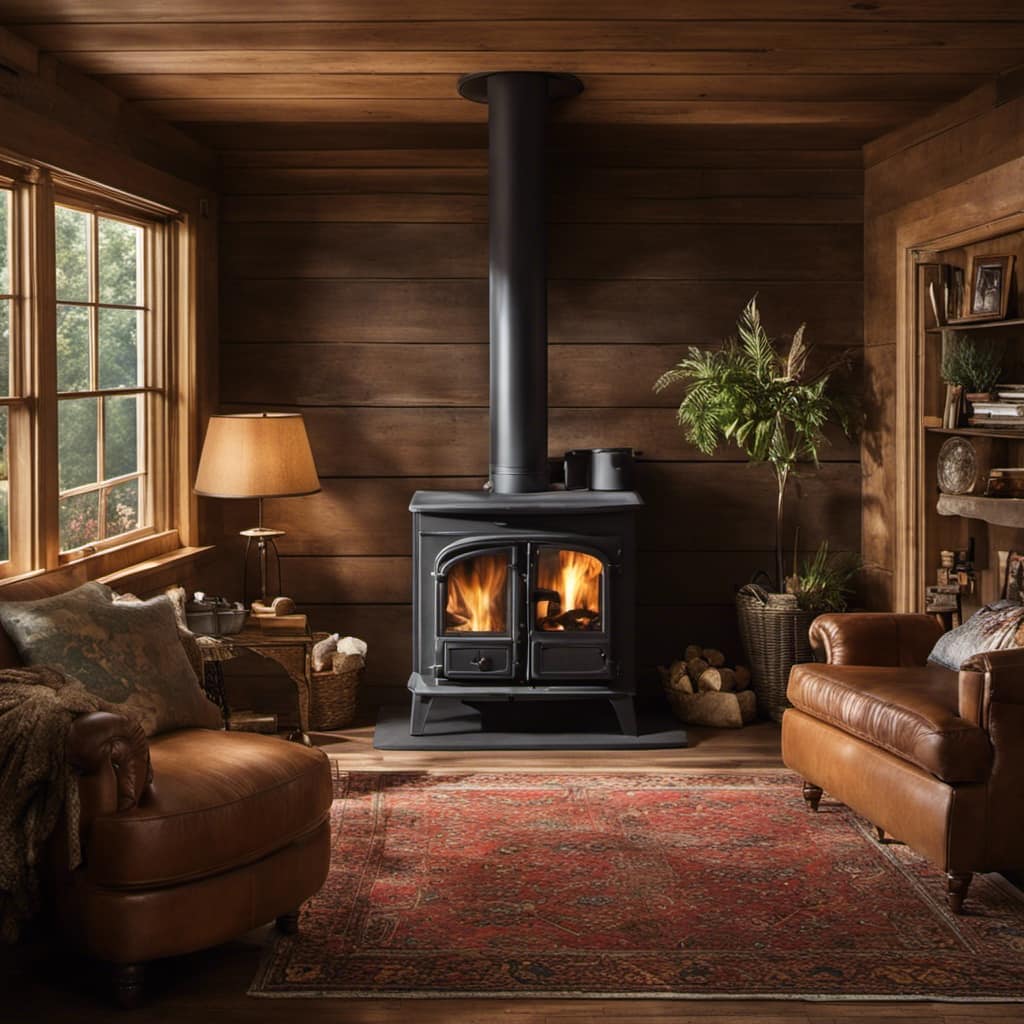
Professional cleaning offers expertise and thoroughness that DIY cleaning may lack, ensuring safety and optimal results.
Cost Comparison Pros/Cons
The cost of cleaning a wood stove chimney should be considered before making a decision. When comparing the cost of cleaning a wood stove chimney, there are a few factors to keep in mind. Here are some pros and cons to consider:
-
DIY Cleaning:
-
Pros:
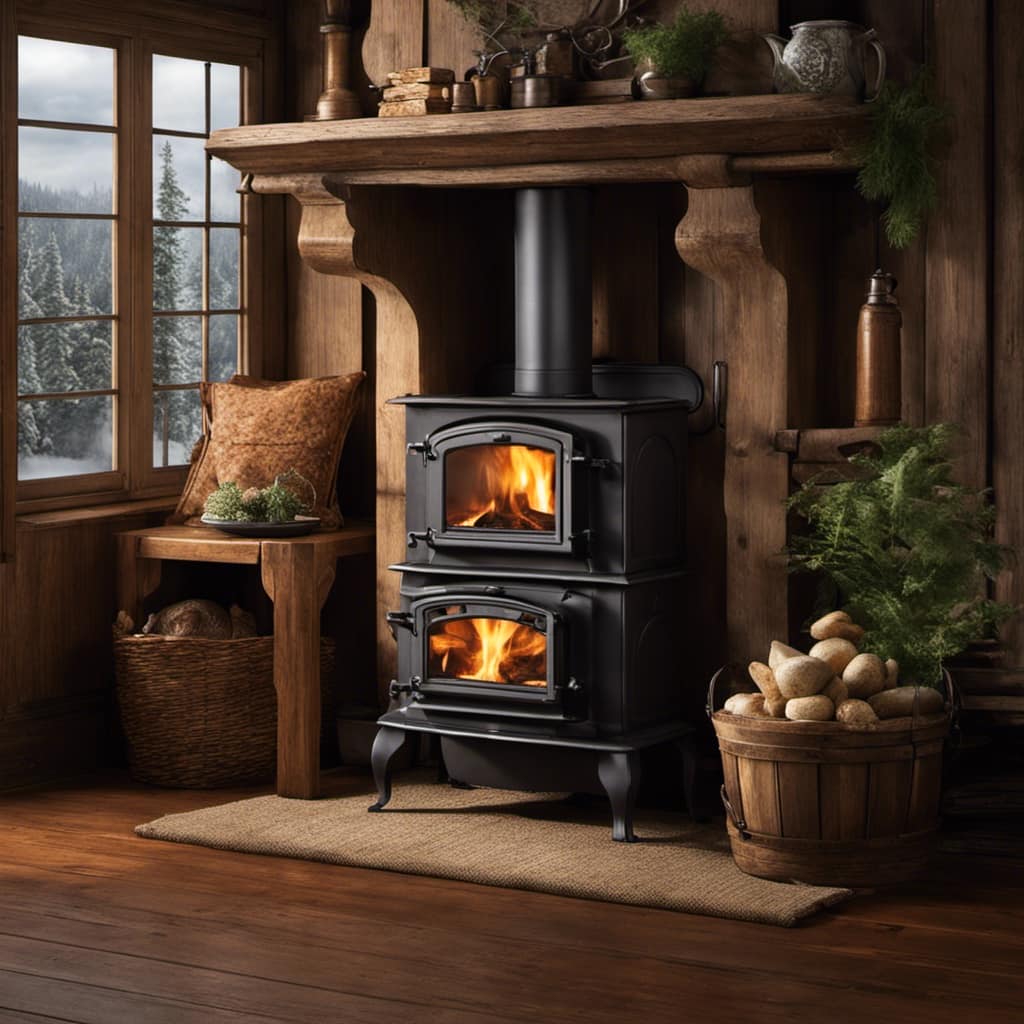
-
Cost-effective as you don’t have to hire a professional.
-
Can be done at your convenience.
-
Allows you to inspect the chimney for any potential issues.
-
Cons:
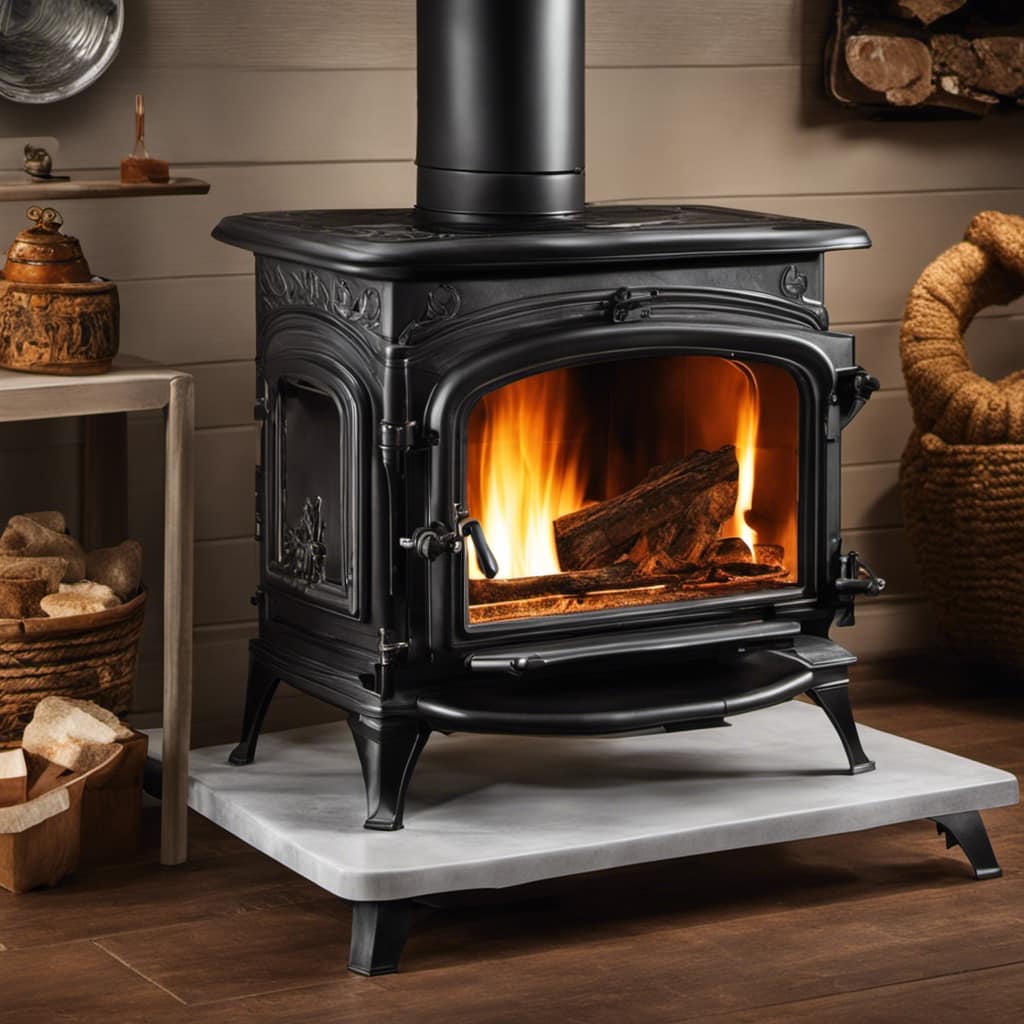
-
Requires time, effort, and knowledge to do it correctly.
-
May not be as thorough as professional cleaning.
-
Safety risks involved if proper precautions aren’t taken.
-
Professional Cleaning:
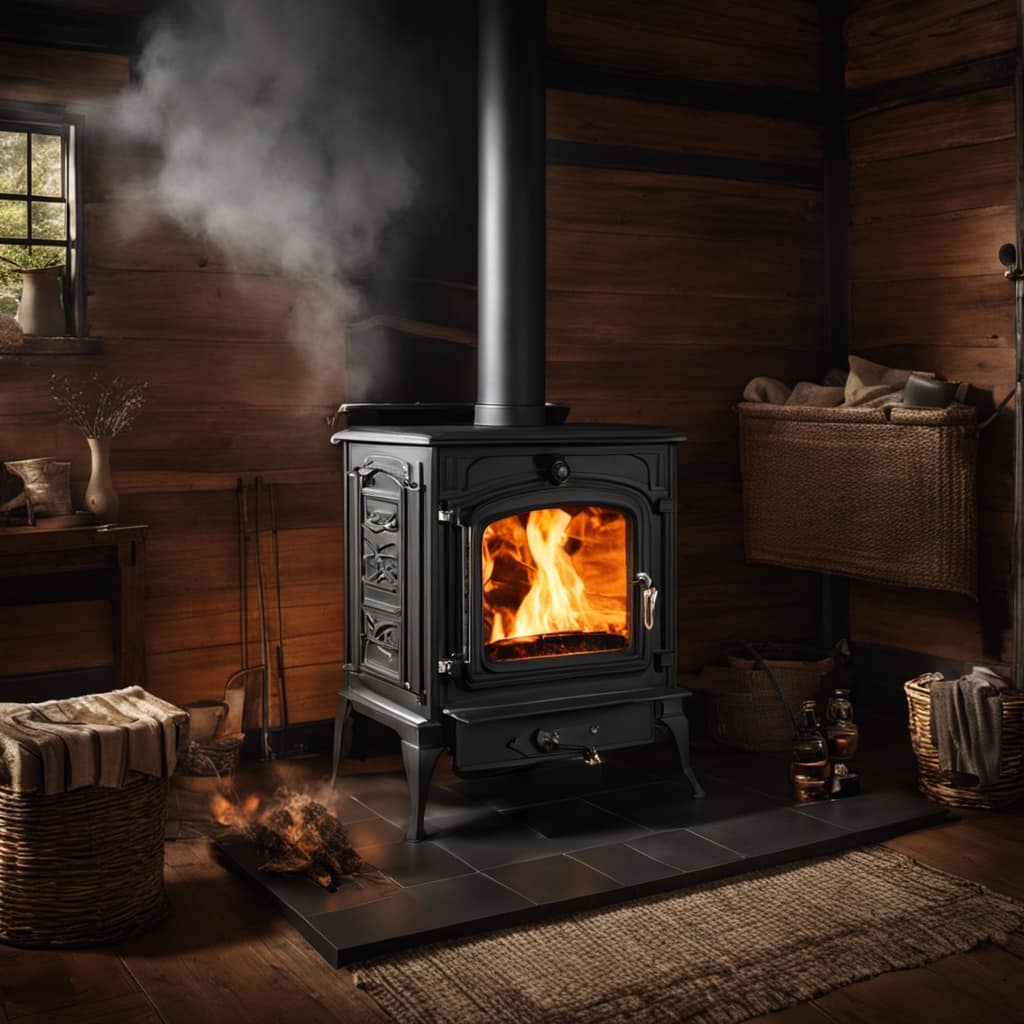
-
Pros:

-
Ensures a thorough and proper cleaning.
-
Professionals have the expertise to identify and address any issues.
-
Reduces the risk of chimney fires and carbon monoxide leaks.
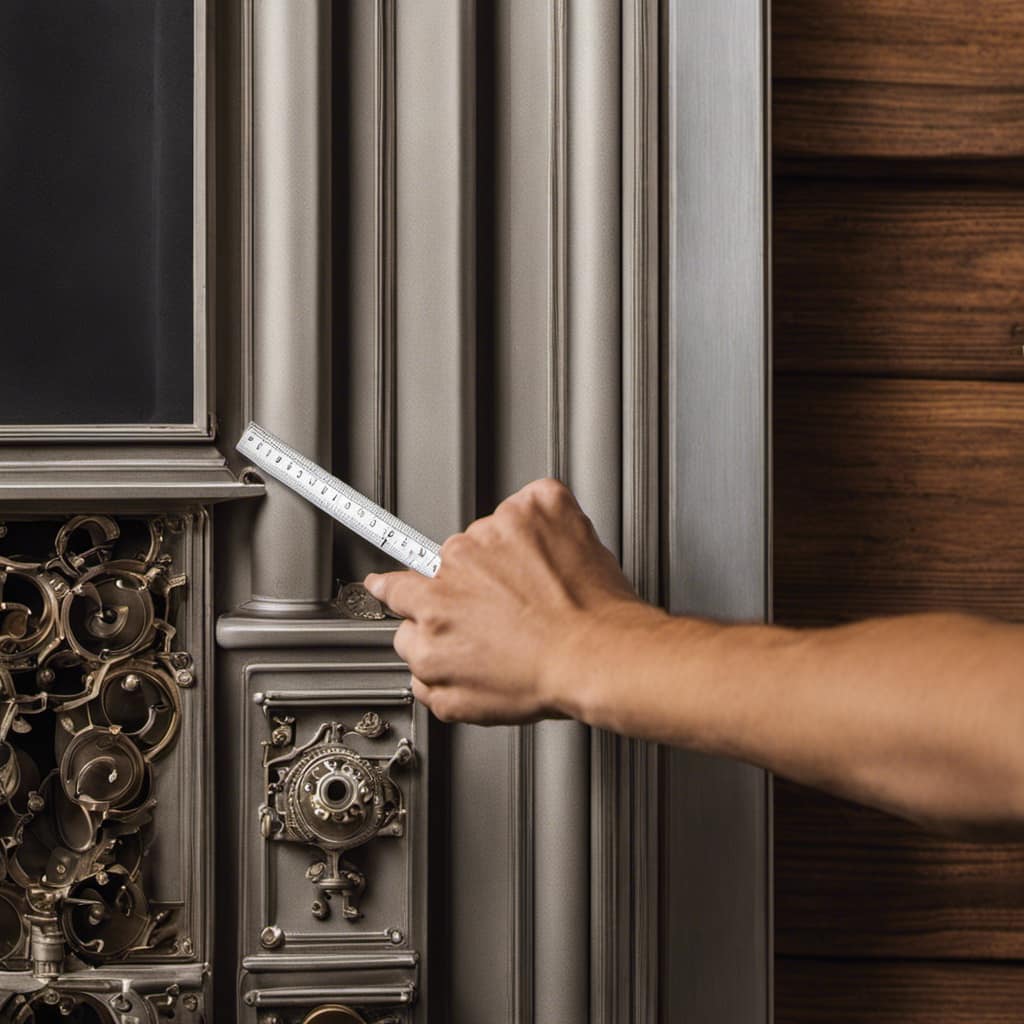
-
Cons:

-
Can be more expensive than DIY cleaning.
-
Requires scheduling and relying on a professional’s availability.
Ultimately, the cost comparison between DIY cleaning and professional cleaning will depend on your budget, time availability, and comfort level with DIY tasks.
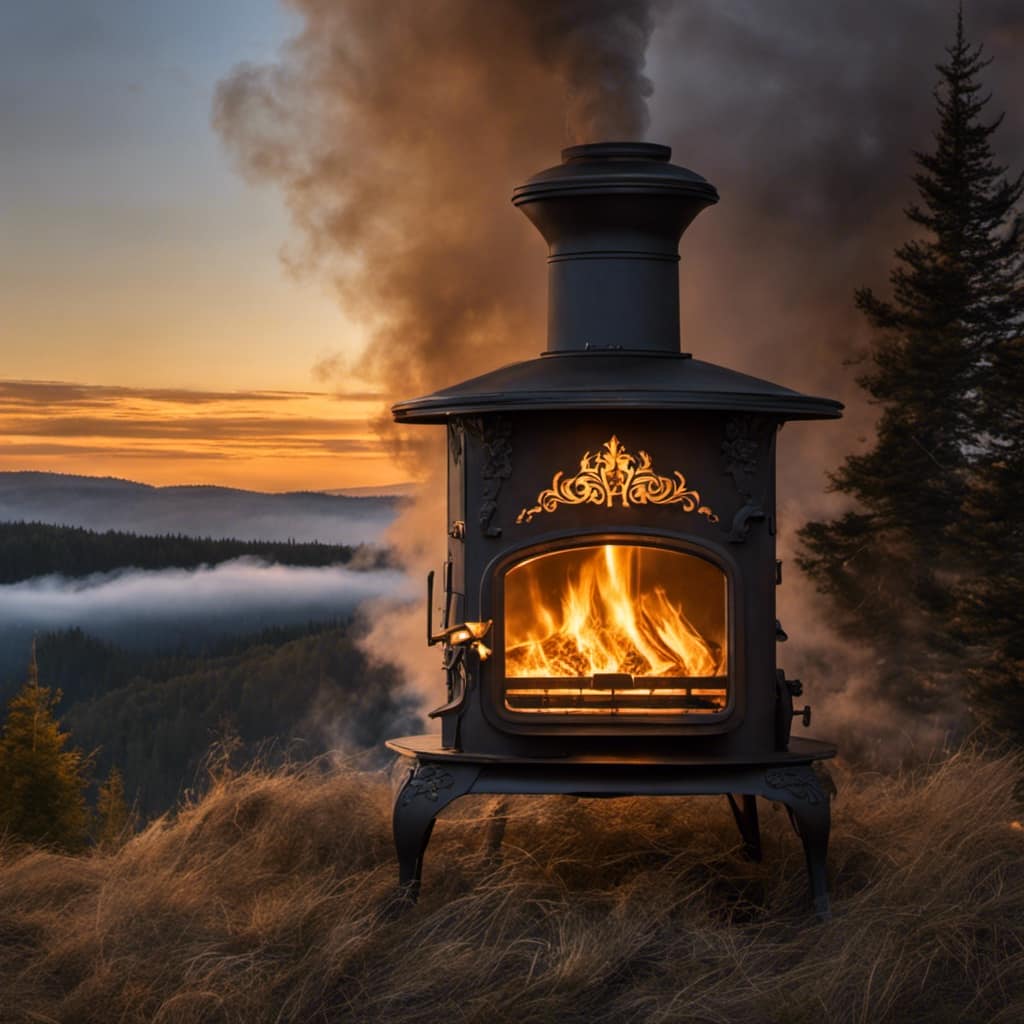
Safety Risks of DIY
I should be aware of the safety risks involved in doing it myself.
Cleaning a wood stove chimney may seem like a simple task, but it’s important to recognize the potential hazards. One of the main risks involved is the buildup of creosote, a highly flammable substance that can accumulate in the chimney. If not properly cleaned, it can lead to chimney fires that can quickly spread to the entire house.
Another risk is the release of harmful gases, such as carbon monoxide, which can be deadly if inhaled in high concentrations. Additionally, climbing on the roof or using ladders to access the chimney can also pose a risk of falls and injuries.
Therefore, it’s crucial to prioritize safety and consider hiring a professional chimney sweep who’s trained and equipped to handle these risks effectively.

Tips for Cleaning Safely
To clean the wood stove chimney safely, it’s important to wear protective gloves and goggles. Safety precautions should be taken seriously to avoid any accidents or injuries. Here are some tips for cleaning your wood stove chimney safely:
- Clear the area around the stove and ensure there are no flammable materials nearby.
- Use a sturdy ladder or scaffold to safely access the chimney from the roof.
- Prior to cleaning, ensure the wood stove is completely cool.
- Place a drop cloth or tarp around the wood stove to catch any debris or soot that may fall.
- Use a chimney brush specifically designed for wood stove chimneys to effectively remove soot and creosote buildup.
Cleaning techniques may vary depending on the type of chimney you have, so it’s important to consult the manufacturer’s guidelines or seek professional advice if needed. Regular chimney cleaning is essential to prevent chimney fires and maintain optimal stove performance.
Now that we’ve covered the safety precautions and cleaning techniques, let’s move on to the tools and supplies needed for a successful chimney cleaning.
Tools and Supplies Needed
After gathering the necessary tools and supplies, I began my chimney cleaning process. It is important to have the right tools and equipment to ensure a thorough and efficient cleaning. Here is a list of the essential tools and supplies needed for chimney cleaning:
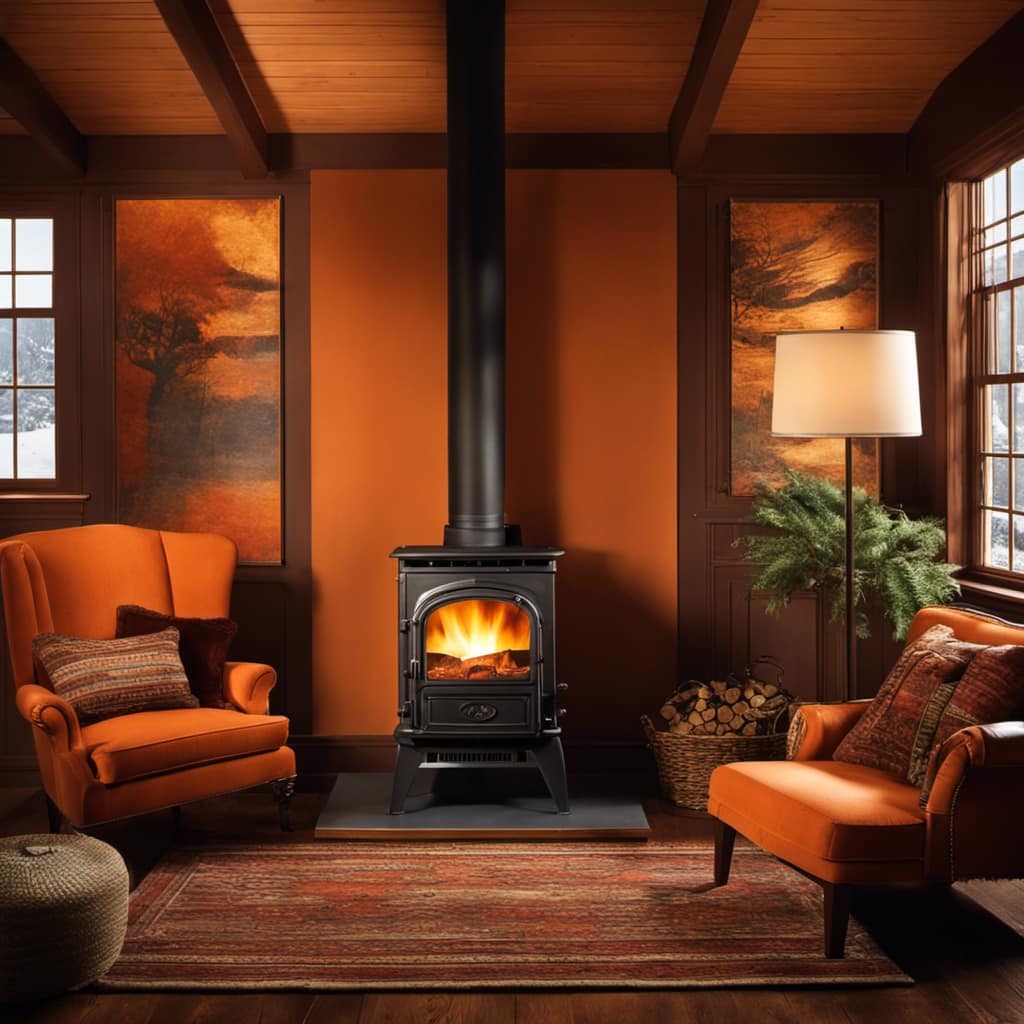
| Tools and Equipment | Cleaning Techniques |
|---|---|
| Chimney brush | Use a chimney brush to scrub away soot and creosote buildup from the chimney walls. Make sure to choose a brush that is the appropriate size for your chimney. |
| Drop cloth | Lay down a drop cloth to protect the surrounding area from any debris that may fall during the cleaning process. This will make the cleanup easier later on. |
| Safety goggles and gloves | Wear safety goggles and gloves to protect yourself from any flying debris or chemicals during the cleaning process. Safety should always be a top priority. |
| Vacuum cleaner | Use a vacuum cleaner with a long hose attachment to remove any loose debris from the fireplace and chimney. This will help prevent the debris from falling back into the room. |
Benefits of a Clean Chimney
Having a clean chimney improves the safety and efficiency of my fireplace. Regular cleaning of the chimney offers several benefits that contribute to a better indoor environment and a more enjoyable fireplace experience. Here are some key advantages of keeping my chimney clean:
-
Reduces the risk of chimney fires: A clean chimney prevents the build-up of flammable creosote, which can ignite and cause a dangerous chimney fire.
-
Improves airflow: A clean chimney allows for proper airflow, which enhances the efficiency of the fireplace and reduces the chances of smoke backing up into the house.
-
Extends the lifespan of the chimney: Regular cleaning removes debris and prevents the accumulation of corrosive substances, helping to prolong the life of the chimney.

-
Enhances indoor air quality: A clean chimney ensures that harmful pollutants and toxins, such as carbon monoxide, are properly vented outside, improving the indoor air quality.
-
Prevents chimney blockages: Regular cleaning removes bird nests, leaves, and other obstructions that can block the chimney, preventing smoke and gases from escaping.
Regular chimney cleaning not only improves the safety and efficiency of my fireplace but also has a positive impact on indoor air quality. By keeping my chimney clean, I can enjoy a cozy and worry-free fireplace experience while ensuring a healthy environment for my family.
Frequently Asked Questions
Can I Clean My Wood Stove Chimney Myself if I Have Never Done It Before?
Yes, you can definitely clean your wood stove chimney yourself even if you’ve never done it before. There are DIY chimney cleaning tips available that can guide you through the process.

However, it’s important to note that professional chimney cleaning is necessary at least once a year to ensure proper maintenance and safety. If you feel confident in your abilities and have the necessary tools, you can give it a try, but always prioritize safety and consider hiring a professional for regular maintenance.
How Long Does It Typically Take to Clean a Wood Stove Chimney?
When it comes to cleaning a wood stove chimney, the time it typically takes can vary depending on a few factors. Factors such as the size of the chimney and the amount of buildup will determine the duration.
Additionally, the tools needed to clean a wood stove chimney include a chimney brush, a ladder, and a vacuum.
It’s important to be thorough and meticulous when cleaning to ensure the chimney is properly maintained and functioning efficiently.
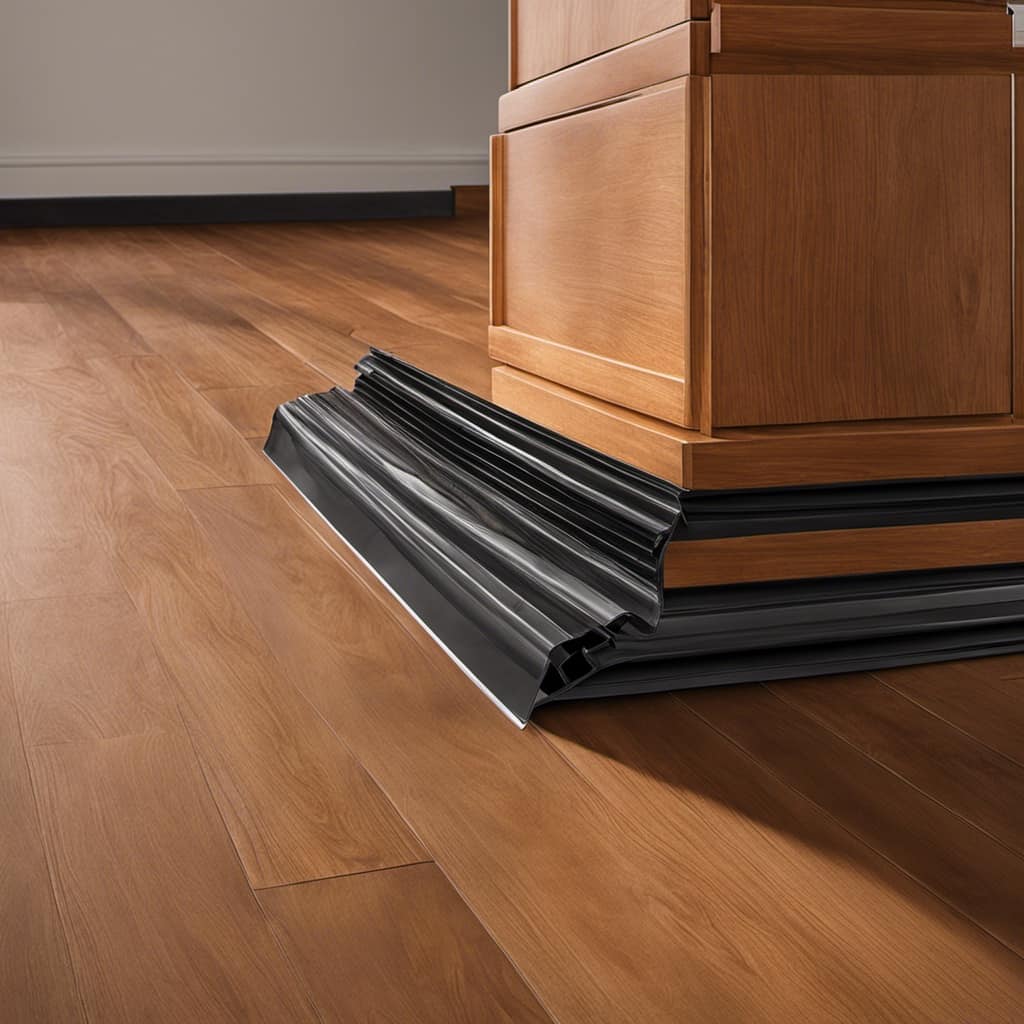
Is It Necessary to Clean the Chimney if I Only Use My Wood Stove Occasionally?
If you only use your wood stove occasionally, you may be wondering if it’s necessary to clean the chimney. While it’s tempting to think that infrequent use means less buildup, the truth is that even occasional use can lead to creosote accumulation.
This highly flammable substance can pose a serious fire hazard if not regularly removed. To ensure your safety, it’s recommended to clean your wood stove chimney at least once a year, regardless of how often you use it.
Are There Any Specific Safety Precautions I Should Take While Cleaning My Wood Stove Chimney?
When it comes to cleaning my wood stove chimney, I always make sure to take specific safety precautions.
First, I wear protective gloves and goggles to shield myself from any debris.
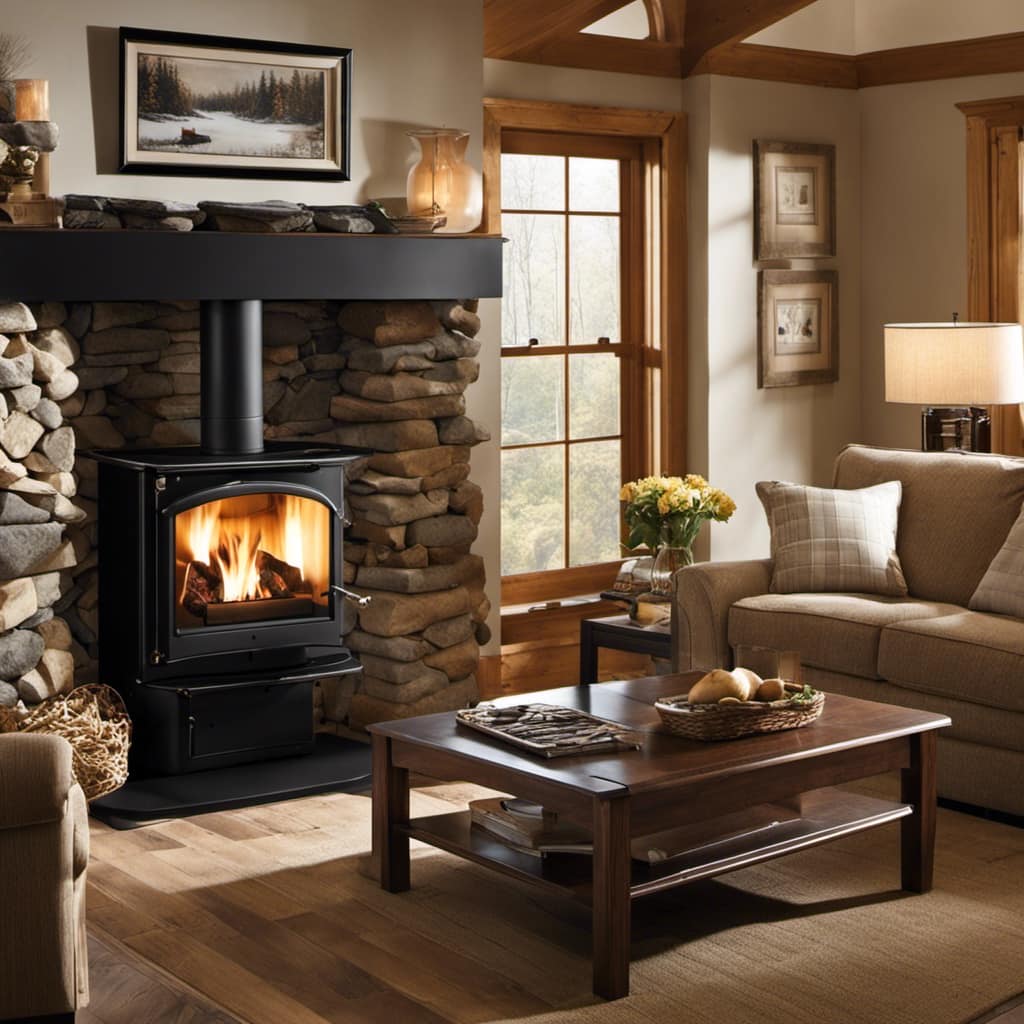
I also make sure to have a sturdy ladder and someone to assist me in case of any accidents.
As for cleaning techniques, I use a chimney brush and rods to remove any creosote buildup.
Regular cleaning and inspection ensure a safe and efficient wood stove operation.
Can a Dirty Wood Stove Chimney Affect the Efficiency of My Wood Stove?
A dirty wood stove chimney can significantly impact the efficiency of your wood stove. When the chimney is clogged with creosote and debris, it restricts the airflow, causing the stove to burn less efficiently and produce less heat.
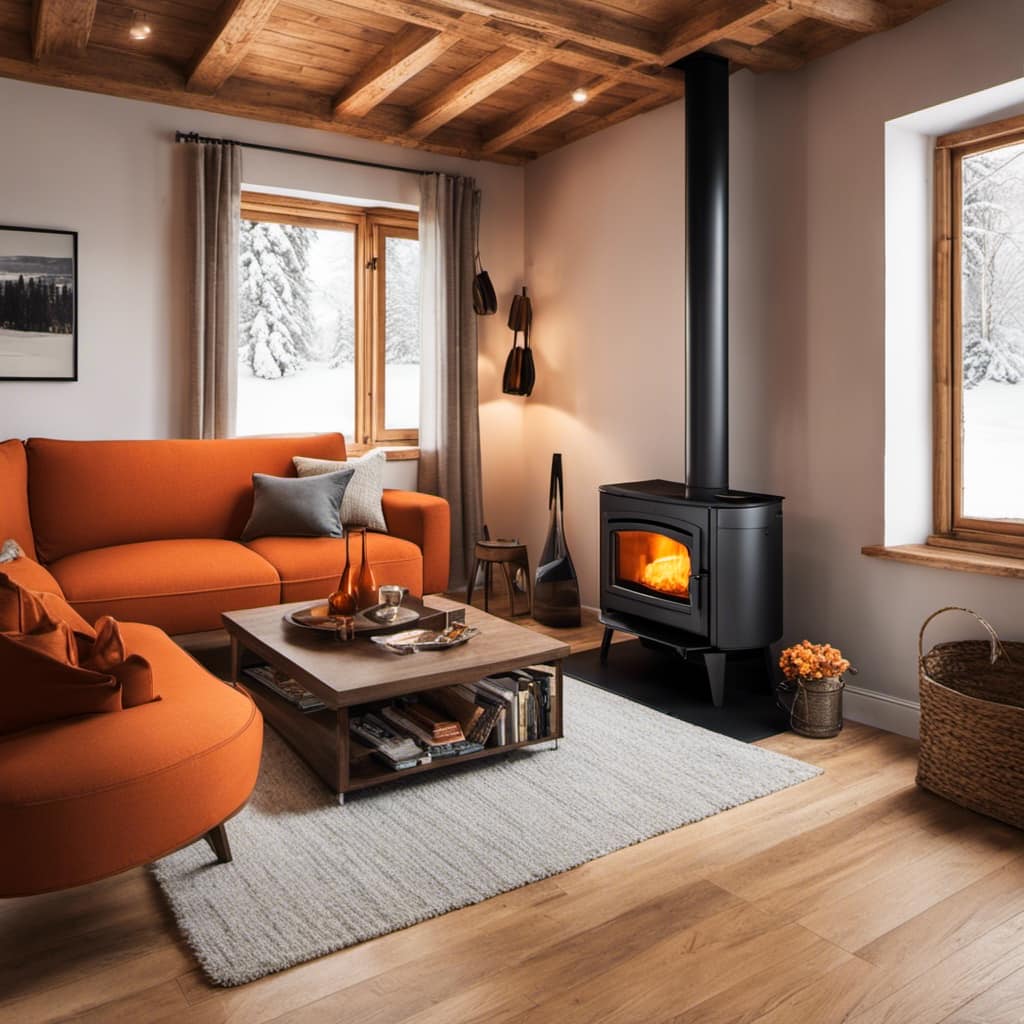
This means you’ll use more wood to achieve the desired warmth, resulting in higher fuel consumption and increased costs. Regular chimney cleaning is crucial to maintain the optimal performance of your wood stove and ensure its efficiency doesn’t go up in smoke.
Conclusion
In conclusion, regular cleaning and maintenance of your wood stove chimney is vital for the safety and efficiency of your wood-burning system.
According to a study by the Chimney Safety Institute of America, it’s recommended to have your chimney cleaned at least once a year. Failure to do so can lead to the build-up of creosote, which is highly flammable and can cause chimney fires.
By following a proper cleaning schedule and ensuring the chimney is free from debris, you can enjoy a safer and more efficient wood stove.
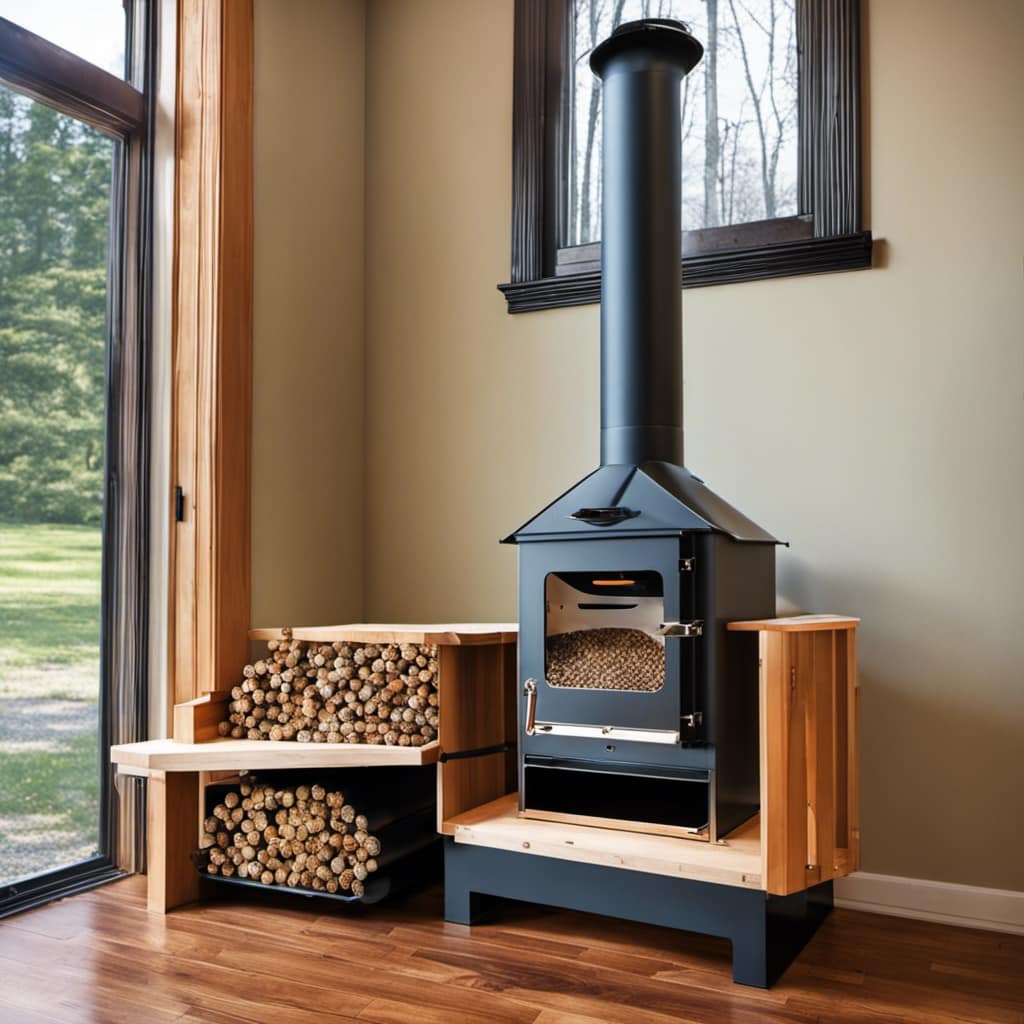
Growing up surrounded by the vast beauty of nature, Sierra was always drawn to the call of the wild. While others sought the comfort of the familiar, she ventured out, embracing the unpredictable and finding stories in the heartbeat of nature.
At the epicenter of every remarkable venture lies a dynamic team—a fusion of diverse talents, visions, and passions. The essence of Best Small Wood Stoves is crafted and refined by such a trio: Sierra, Logan, and Terra. Their collective expertise has transformed the platform into a leading authority on small wood stoves, radiating warmth and knowledge in equal measure.





